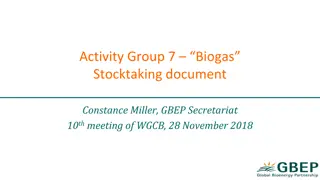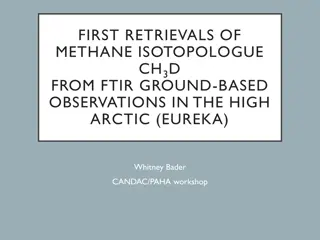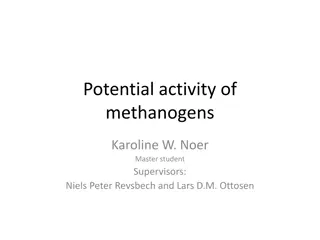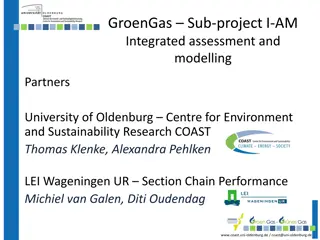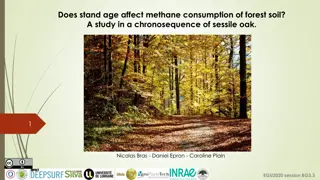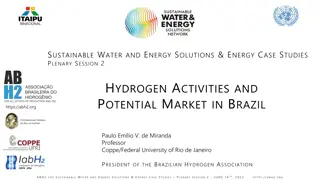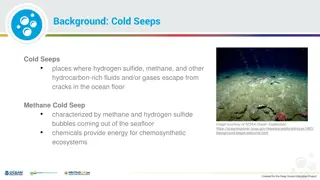Biogas Production and Methane Content Measurement in Biodigester Research
Explore the process of collecting data in biodigester studies, focusing on biogas production, methane content, and related measurements. Learn how to read water levels, measure biogas, and assess methane content using sodium hydroxide or potassium hydroxide solutions. Practice techniques with fermentation tubes and syringes while prioritizing safety measures. Understand the significance of methane as a combustible fuel compared to carbon dioxide in biodigester research.
Download Presentation

Please find below an Image/Link to download the presentation.
The content on the website is provided AS IS for your information and personal use only. It may not be sold, licensed, or shared on other websites without obtaining consent from the author.If you encounter any issues during the download, it is possible that the publisher has removed the file from their server.
You are allowed to download the files provided on this website for personal or commercial use, subject to the condition that they are used lawfully. All files are the property of their respective owners.
The content on the website is provided AS IS for your information and personal use only. It may not be sold, licensed, or shared on other websites without obtaining consent from the author.
E N D
Presentation Transcript
What data are you collecting? Biogas production Methane content Presence of carbon dioxide pH Qualitative observations Digestate color Turbidity Signs of aerobic digestion (mold, fungus) Any others relevant to your group s research question? 2
Biogas production How do we read the water level in a graduated cylinder? How do we know how much biogas is in the graduated cylinder? Measure the water level in the graduated cylinder. Subtract the water level from the previous reading (or initial value). Record your data in your data table for the day since startup. 3
Methane content of the biogas Q: Biogas is mostly methane (CH4) and carbon dioxide (CO2). Which is more useful to us? 4
Methane content of the biogas A: Methane is more useful to us because it can be burned as fuel. Carbon dioxide is not combustible. 5
Measuring methane content Materials: 3 molarity solution of Sodium hydroxide (NaOH) -- available as lye -- or Potassium hydroxide (KOH) Fermentation tube Syringe with blunt needle 6
Measuring methane content Let s practice with a fermentation tube! 1. Fill the tube with water 2. Fill the syringe with air 3. Inject the syringe of air into the fermentation tube Try to do this without letting any bubbles escape the tube and without spilling any water. Be careful, these fermentation tubes are typically very fragile! Be sure to use proper PPE. 7
Measuring methane content You are using a strong basic solution be careful and use proper PPE. 1. Over a basin or sink, carefully pour the NaOH or KOH solution into a fermentation tube, tipping it so that it is full up to the round bulb near the base (see image on previous slide). 2. Unclamp the third line of tubing extending from the gas T and withdraw 3 mL of biogas. Replace the clamp. 3. Carefully inject the gas into the base solution, making sure no bubbles escape. 4. Measure the final volume. All the gas at the top of the tube is methane. The methane content is the final volume at the top of the fermentation tube divided by the total injected volume (3 mL). It is typically expressed as a percent. 8
Measuring methane content How does the fermentation tube method work? What happens to the CO2and what happens to the NH4 in the fermentation tube? 9
Measuring methane content How does the fermentation tube method work? What happens to the CO2and what happens to the NH4 in the fermentation tube? Psst here s a hint 10
Measuring methane content CO2is a gas, but it is polar and quickly turns into a different, non- gaseous product that dissolves in the water. KOH (liquid)+ CO2 (gas) K2CO3 (solid) + H2O(liquid) NaOH (liquid)+ CO2 (gas) Na2CO3 (solid) + H2O(liquid) NH4is nonpolar, so it is insoluble in water and passes through the solution. Because biogas is a mixture of methane and carbon dioxide, everything at the top of the fermentation tube is methane. Can you think of another gas besides methane that might pass through the solution? 11
Detecting the presence of carbon dioxide How do we know if carbon dioxide (CO2) is present in the biogas? 1. Fill a test tube with lime water 2. Withdraw 3 mL of biogas from the biodigester 3. Slowly bubble the biogas through the lime water. Observe the lime water. What do you see? Elevise Carbon dioxide is present if the lime water becomes cloudy. 12
Detecting the presence of carbon dioxide Why does this method work? Here s a hint: CO2(gas) +Ca(OH)2 (aqueous) CaCO3 (solid)+ H2O(liquid) Elevise 13
Detecting the presence of carbon dioxide Why does this method work? Here s a hint: CO2(gas) +Ca(OH)2 (aqueous) CaCO3 (solid)+ H2O(liquid) Calcium carbonate forms a solid precipitate, which is not soluble in water and precipitates. Elevise 14
Measuring pH We will use pH strips to determine the acidity of the biodigester s contents. This can be done at the end of the experiment, or throughout the experiment if you have a two-holed rubber stopper and an extra access point. The optimum pH is between 6.5 and 8.5. A pH above or below this range will inhibit the microorganisms. 15
Measuring pH using pH Strips Materials Sample of water before it is filtered. Sample of water after it is filtered. pH strips. Indicator chart on pH strip package. Instructions Test the water before it is filtered: 1. Place pH strip in water sample for 2 seconds. 2. Take the strip out of the sample and wait 10 seconds for color to stabilize . 3. Match color on strip with chart on package (at least two students should agree on the color match) 4. Write value on your data sheet. Repeat with the filtered water. 16
Qualitative observations How does the biodigester look? Digestate color Turbidity Signs of mold or fungus, usually on the surface of the liquid Record your observations for each measurement day. 17
Qualitative observations Q: If we see signs of mold or fungus, what is happening inside the reactor? Q: Why is it a problem? 18
Qualitative observations Q: If we see signs of mold or fungus, what is happening inside the reactor? Mold and fungus are aerobic organisms their presence indicates air in the system. Q: Why is it a problem? Anaerobic microorganisms need anaerobic conditions to remain competitive in their ecosystem. These conditions give them competitive advantage, the ability to outcompete other organisms. In aerobic conditions, they aren t very competitive because they are slower at eating, growing, and reproducing than aerobic microorganisms. 19
Discussion questions Are there any other tests you can think of performing on the biodigester? What data would you collect with those tests, and what might it tell you about the processes happening within? 20






